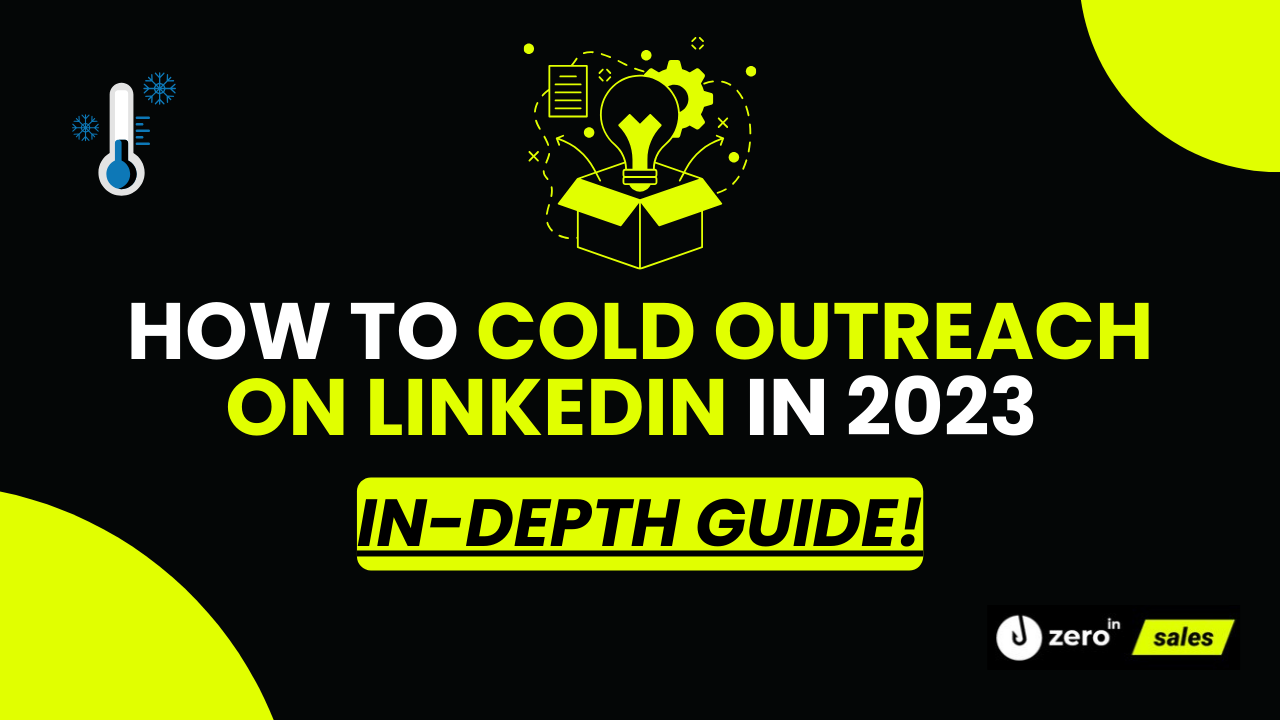Alright, picture this:
You’ve just bought a snazzy piece of IKEA furniture – sleek, modern, just perfect for that empty corner in your living room.
You’ve rolled up your sleeves, ready for some DIY assembly action.
But then, to your dismay, you realize the instructions are missing.
You stare at the nuts, bolts, and random pieces of wood strewn around, feeling an uncanny sense of dread and confusion.
Now, let’s take that same bewilderment and transport it into the digital realm, onto a platform teeming with potential collaborators, clients, and industry mavens – LinkedIn.
Cold outreach on LinkedIn can feel just like that IKEA furniture assembly, puzzling and, quite honestly, a bit intimidating.
But don’t worry.
This is where the good news comes in.
You’ve landed on the right page.
This comprehensive guide is designed to be the IKEA instruction manual to your LinkedIn cold outreach strategy.
It’s crafted meticulously to help you understand, execute, and succeed at cold outreach on LinkedIn.
It’s detailed, thoughtful, and we promise, it’s much easier to follow than any flat-pack furniture guide.
Summary
In the following sections, you’ll find a wealth of knowledge, insights, and practical strategies to make cold outreach on LinkedIn as effortless as making your morning coffee.
From the unexplored nuances of LinkedIn etiquette to the finesse of crafting compelling connection requests, to the art of follow-ups, this guide aims to cover every aspect of cold outreach.
All, so you can make the most out of LinkedIn’s potential in 2023.
As we tread together on this path, the convoluted jargon and the uncertainty will slowly fade away, much like the apprehension you might feel at the beginning of your IKEA furniture assembly journey.
By the end, you’ll find yourself with a sturdy, sleek desk – or, in this case, a strong, effective LinkedIn outreach strategy that not only works, but thrives.
That’s our promise.
So, buckle up and get ready to turn LinkedIn into your playground.
Welcome to our in-depth guide on how to cold outreach on LinkedIn in 2023.
You’ve got this. We’ve got your back. Let’s do this together.
What is considered as Cold Outreach on LinkedIn?
Welcome to the first checkpoint on your assembly line – understanding what we refer to when we say “Cold Outreach” on LinkedIn.
Now, if you’re here, chances are you already have a fair idea of what cold outreach is. But just to align our compasses, let’s paint a clearer picture.
In the simplest terms, LinkedIn cold outreach is the digital equivalent of introducing yourself to a stranger at a business conference, with an aim to build a professional relationship.
It’s the act of identifying and reaching out to potential clients, partners, or collaborators on LinkedIn whom you’ve had no prior contact with.
LinkedIn, with its robust platform of over 930 million professionals worldwide, serves as an ideal ‘conference room’ for conducting such outreach.
It provides a suite of tools and features designed to aid in this process – from finding the right ‘strangers’ that align perfectly with your ICP to crafting personalized messages to catch their attention.
Now, why is it called ‘cold’?
Obviously, it’s called so because this method involves initiating contact with individuals who aren’t expecting your outreach, much like a ‘cold’ call or a ‘cold’ email.
This cold approach, however, should not be mistaken for an unwelcome interruption.
When done right, LinkedIn cold outreach can open doors to meaningful conversations and potential business relationships.
Think of it as a friendly, professional nudge, a tap on the shoulder if you will, aimed at sparking a conversation and, eventually, forming connections that can fuel your business growth in 2023 and beyond.
But how exactly do you perform cold outreach on LinkedIn and make the most of it? That’s what we’re here to discover. So, let’s roll up our sleeves and get to work!
Why should you utilize LinkedIn as your “Go-To’’ for Cold Outreach?
Why LinkedIn, you ask?
Why not stick to the traditional methods of cold emailing or calling?
Well, it’s like asking why use a state-of-the-art, fully automated toolbox when you can try to assemble your IKEA furniture with a single, worn-out screwdriver.
Sure, you might eventually get it done, but the process will likely be far from efficient or enjoyable.
Let’s take a step back and consider the current landscape.
In an age where most inboxes are perpetually swamped with promotional emails and spam, your cold email can easily get lost in the crowd.
And don’t even get us started on the diminishing popularity and effectiveness of cold calls!
This is where LinkedIn, a platform designed for professionals seeking to connect, comes to the rescue. It’s like a breath of fresh air in an otherwise flooded digital world.
Here are a few reasons why LinkedIn should be your go-to platform for cold outreach:
1. Less Flooded Inbox
Think about your email inbox for a moment.
It’s likely overflowing with newsletters, work emails, promotions, and of course, unsolicited messages.
Now, that’s a tough crowd to compete with, isn’t it?
LinkedIn, however, provides a less crowded space for your messages to be seen and acknowledged.
While LinkedIn inboxes are not immune to clutter, they are typically less chaotic than email inboxes, hence offering your messages a higher chance of standing out.
2. Higher Response Rate
On LinkedIn, you’re not just another anonymous email in the recipient’s inbox.
You have a face, a profile, a history – all visible to the person you’re reaching out to.
This transparency often translates into trust, leading to a higher response rate compared to traditional email outreach.
3. Professional Environment
LinkedIn is a platform designed for professionals to network, learn, and do business.
It’s a community where people expect to make professional connections and discuss industry-related matters.
This context increases the likelihood of your outreach being well-received, as it aligns with the purpose of the platform.
4. Powerful Search and Segmentation Tools
LinkedIn offers powerful search functionality, including filters for industry, location, company size, job title, and more.
This allows you to precisely pinpoint your ideal clients or partners, making your outreach efforts more targeted and effective.
5. Potential for Warm Introductions
LinkedIn allows you to see mutual connections, which can be used to facilitate introductions or referrals. This could potentially turn your cold outreach into a warm one, increasing the chances of a positive response.
6. Constant Evolution
LinkedIn is continuously evolving, introducing new features and tools designed to facilitate better networking.
Being an active user gives you the opportunity to leverage these updates and stay ahead of the curve.
So, whether you’re an entrepreneur, a sales rep, a recruiter, or simply someone looking to grow their network, LinkedIn presents an invaluable opportunity for cold outreach. It’s a rich reservoir waiting to be tapped.
Are you ready to dive in?
How to Perform Cold Outreach On LinkedIn in 2023?
In this IKEA-furniture-assembly journey of LinkedIn cold outreach, you’ve picked out the right product (the LinkedIn platform), understood the basics (what is cold outreach), and recognized why it’s the best choice (why choose LinkedIn for cold outreach).
Now, it’s time to start putting together the pieces.
Let’s delve into how to perform cold outreach on LinkedIn effectively:
LinkedIn Connection Request First
Imagine walking into a room full of potential business partners.
Would you jump into a sales pitch right away?
Probably not.
The polite and effective approach would be to introduce yourself first, establish some rapport, and then dive into business matters.
The same goes for LinkedIn.
Your first step should be sending a connection request. But hold on, not just a bare connection request!
Always remember to attach a small, personalized note with it.
Yes, some stats suggest that requests without notes might have a higher acceptance rate, but think about it from the recipient’s perspective.
A note shows that you’ve taken the time to understand their profile, their needs, and their challenges. It adds a touch of personalization, which is always appreciated in professional scenarios.
Send Direct Messages
After a successful connection, it’s time to get the conversation rolling through direct messages.
Remember, LinkedIn is not a platform for hard selling – it’s a space to build and nurture professional relationships.
After all, no one wants to be on the receiving end of a hard sales pitch right off the bat.
When crafting your direct message strive to provide value, pique interest, or simply engage in a meaningful conversation.
Make your message about them, not you.
It’s your conversation starter, the ice-breaker, so ensure it resonates with your new connection.
Inmails – Second Chance
In an ideal world, all your connection requests would be accepted, and meaningful conversations would naturally follow. However, we all know that doesn’t always happen.
This is where InMails come in.
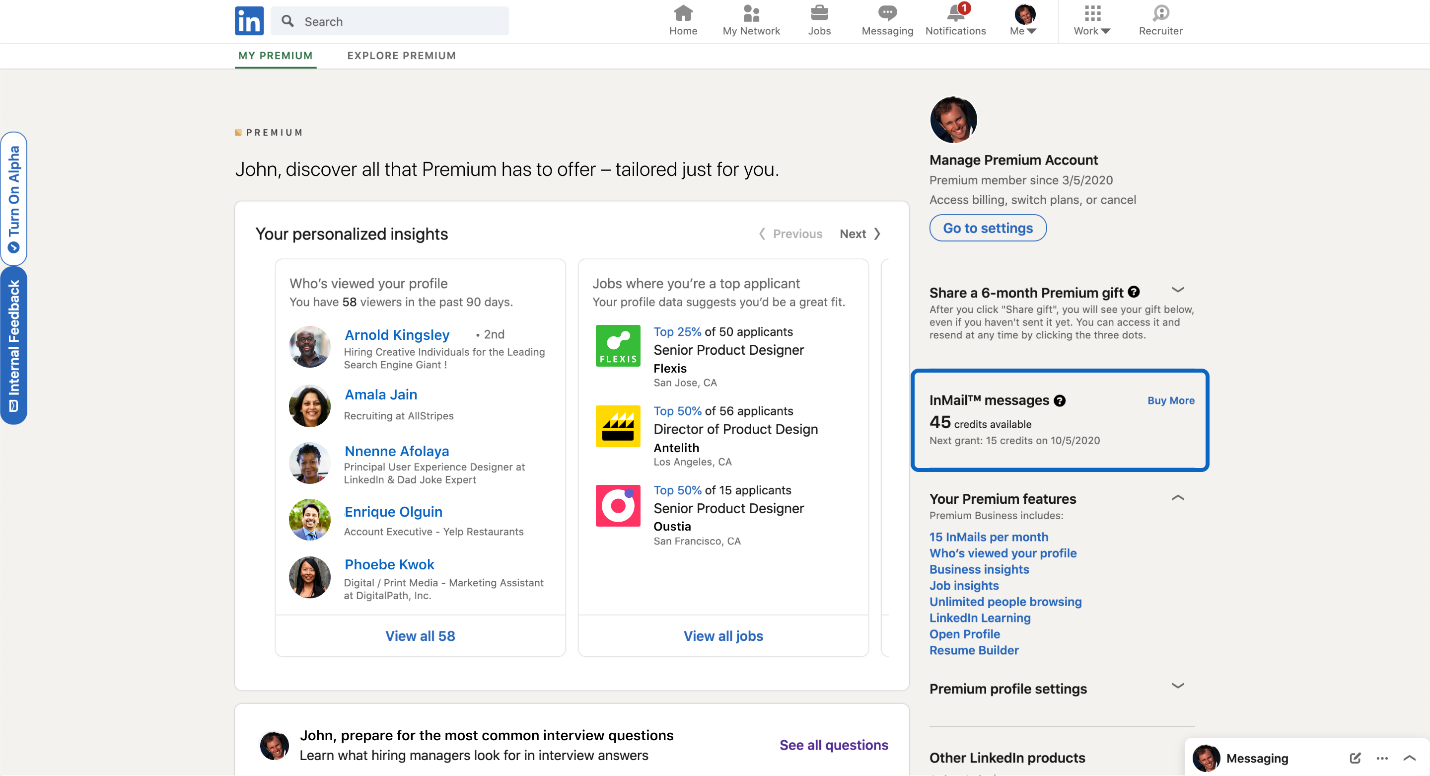
InMails are messages that you can send directly to LinkedIn members you’re not connected with.
They’re part of LinkedIn’s premium features and can be especially useful when your initial connection request doesn’t get a response.
However, as you get a limited number of InMail credits per month with LinkedIn’s Sales Navigator account, it’s essential to use them wisely.
Craft your InMails carefully, making every word count.
Join LinkedIn groups or Attend Events
Lastly, a more indirect yet effective method of performing cold outreach is by participating in LinkedIn groups or events.
This participation allows you to send Message Requests to fellow group members or event participants. These messages land in the ‘Other’ tab of the recipient’s inbox, providing another avenue for you to make an impression.
Being part of groups and events also has an added advantage – it gives you common ground with your prospects, making your outreach more relatable and personal.
Remember, LinkedIn cold outreach, like any relationship-building exercise, requires patience, persistence, and a touch of creativity. It’s not a sprint – it’s a marathon.
So, keep going, keep experimenting, and soon enough, you’ll find a rhythm that works best for you.
However, there’s a lot more that goes into making your LinkedIn cold outreach truly effective.
Up next, we’re going to explore the crucial preparations you should undertake before starting your outreach journey.
How to Prepare for Cold Outreach on LinkedIn?
While diving headfirst into LinkedIn cold outreach might sound exciting, preparation is key to ensuring your efforts yield the desired results.
Think of it as setting up your workbench before you start assembling that IKEA furniture. Having all your tools and materials neatly laid out can make the process smoother and more efficient.
With that said, let’s walk through the steps you need to take before launching your LinkedIn cold outreach campaign:
Prepare your Linkedin profile for your Prospects
Before you even send out that first connection request, you need to ensure that your LinkedIn profile is ready to make a lasting impression.
Your profile is more than just a digital resume – it’s your anding page, providing potential prospects with a snapshot of who you are, what you do, and how you can provide value.
Here are a few key areas to focus on:
Profile Picture: The first thing that catches anyone’s eye is your profile picture. Make sure it’s professional, clear, and friendly. Remember, this is not just about looking good; it’s about appearing trustworthy and approachable.
Headline: Often overlooked, the headline is crucial. It’s your elevator pitch, your chance to summarize your value proposition succinctly. Remember, this, along with your profile picture, is one of the first things your prospects will see when they receive your connection request.
Cover Photo: Your cover photo is a great opportunity to further communicate your professional identity. Use this space wisely to reinforce your brand, your role, or the industry you’re in.
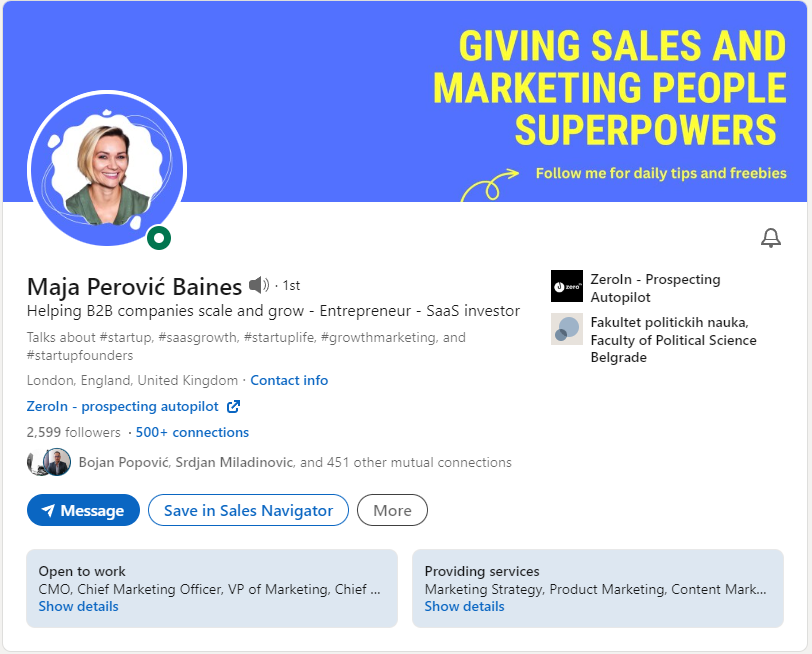
About Section: Finally, the ‘About’ section. Here, you have the chance to delve deeper into your skills, achievements, and unique selling points. Keep it concise, engaging, and remember to highlight how you can provide value to the viewer.
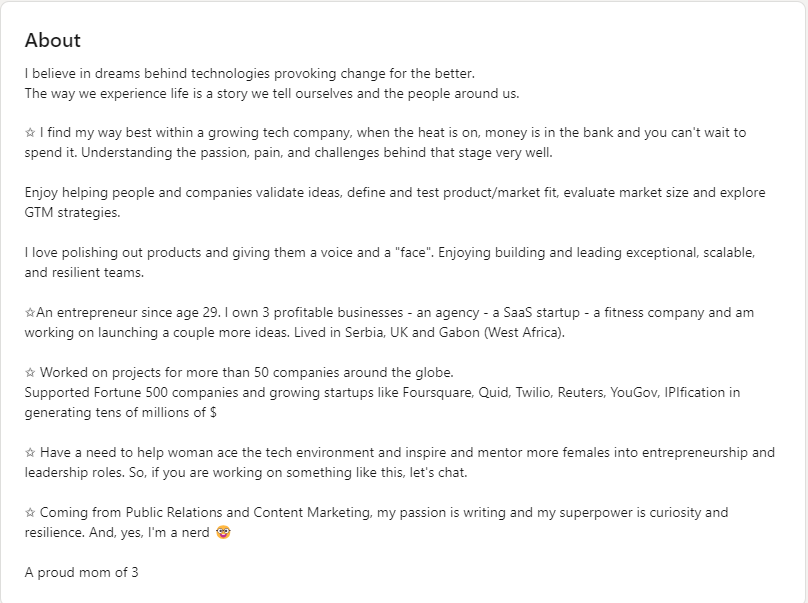
Think of these elements as your virtual handshake.
They form the initial perception about you and can often be the deciding factor between a ‘Connect’ click and a dismissal.
So, invest time in crafting these aspects of your profile, and it can set the tone for successful outreach.
Utilize LinkedIn Sales Navigator for Finding Leads
Imagine trying to find a specific needle in a haystack – challenging, right?
Now imagine having a magnetic tool that could easily draw out that needle.
That’s what LinkedIn Sales Navigator does when it comes to finding potential leads within LinkedIn’s expansive network.
Unlike standard search feature, which can be likened to a pair of binoculars, Sales Navigator is your high-powered telescope.
It takes your search capabilities to another level, providing an almost limitless opportunity to explore LinkedIn’s database.
For $99/month, this premium tool equips you with over 30 advanced search filters.
They are designed to help you effectively identify your target audience, making it an essential tool if LinkedIn outreach is your primary lead generation channel.
Here are some key filter categories:
Company-Specific Attributes: You can search for leads in companies of specific sizes, belonging to certain industries, or even located in particular geographic regions.
Role-Related Aspects: Use this to find people with specific job titles, years of experience, or even those using specific tools or software.
Individual Characteristics: Track down professionals based on their education, skills, or even their interests.
But it doesn’t stop there.
‘Spotlight’ and ‘Posted Content’ filters are like gold mines for your initiatives.
The ‘Spotlight’ category tracks significant activities like job changes, media appearances, and shared posts. This information can offer valuable touchpoints to personalize your messages.
On the other hand, the ‘Posted Content’ filter allows you to identify LinkedIn users who engage with or post content involving certain keywords.
This can help you find prospects already showing interest in your industry, making them ideal leads to approach.
Use Linkedin Boolean Search
Imagine if you could use a specific language to tell Sales Navigator exactly who you want to find. Well, you can. It’s called Boolean search, and mastering it is akin to unlocking a secret treasure chest of qualified leads.
Boolean search helps fine-tune your keyword searches, allowing you to broaden or narrow your search for the perfect leads. It utilizes a series of logical connectors:
– AND: to search for multiple keywords.
– OR: to look for at least one keyword from a list.
– NOT: to exclude certain keywords.
– Parentheses: to combine these connectors.
– Quotes: to look for exact phrases.
You can harness the power of Boolean search in two primary ways: through the keyword filter and the job title filter.
The keyword filter scans every aspect of a profile – including job experiences, skills, descriptions, and recommendations.
In contrast, the job title filter zeroes in exclusively on the current roles held by your prospects.
Let’s say you’re hunting for high-ranking professionals in the realms of Software Development and Data Analysis. Here’s how a Boolean search might look:
(Manager OR “Executive Leader” OR “Chief Officer” OR Supervisor) AND (Software OR “Data Analysis”) NOT (Assistant OR “Junior” OR “Co-Founder”)
This query will generate results like Software Manager, Executive Leader in Data Analysis, Chief Officer in Software, and so forth.
It’s like having a GPS that guides you directly to your target, bypassing any unnecessary detours.
Employing the advanced search filters in tandem with mastering Boolean search is like shining a floodlight into the depths of a moonless night. It illuminates previously concealed opportunities, enhancing your lead-generation process by connecting you with high-quality prospects.
Export your leads into CSV file
Having found your leads using LinkedIn Sales Navigator, the next crucial step is exporting them into a CSV file for easy management and follow-up.
However, LinkedIn Sales Navigator doesn’t natively support exporting leads. Here, a third-party tool like ZeroIn comes into play.
ZeroIn is essentially a business email finder and data export tool for LinkedIn. Let’s walk through how you can use it to export your lead list to a CSV file:
1. Create an Account: Sign up for ZeroIn if you don’t have an account already. If you do, simply log in.
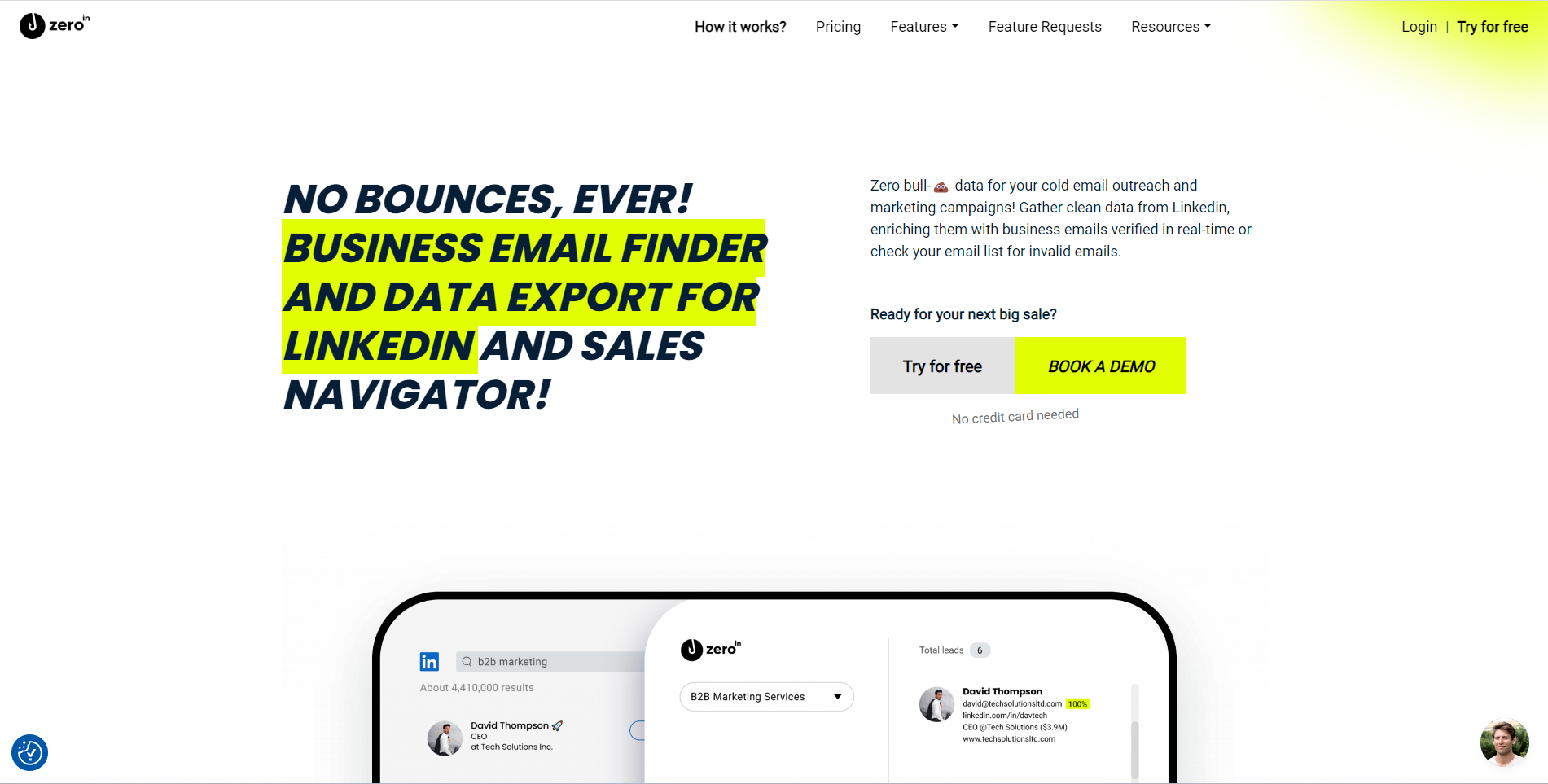
2. Install the Extension: After logging in, install the ZeroIn extension. This extension acts as the bridge between Sales Navigator and your desired CSV file.
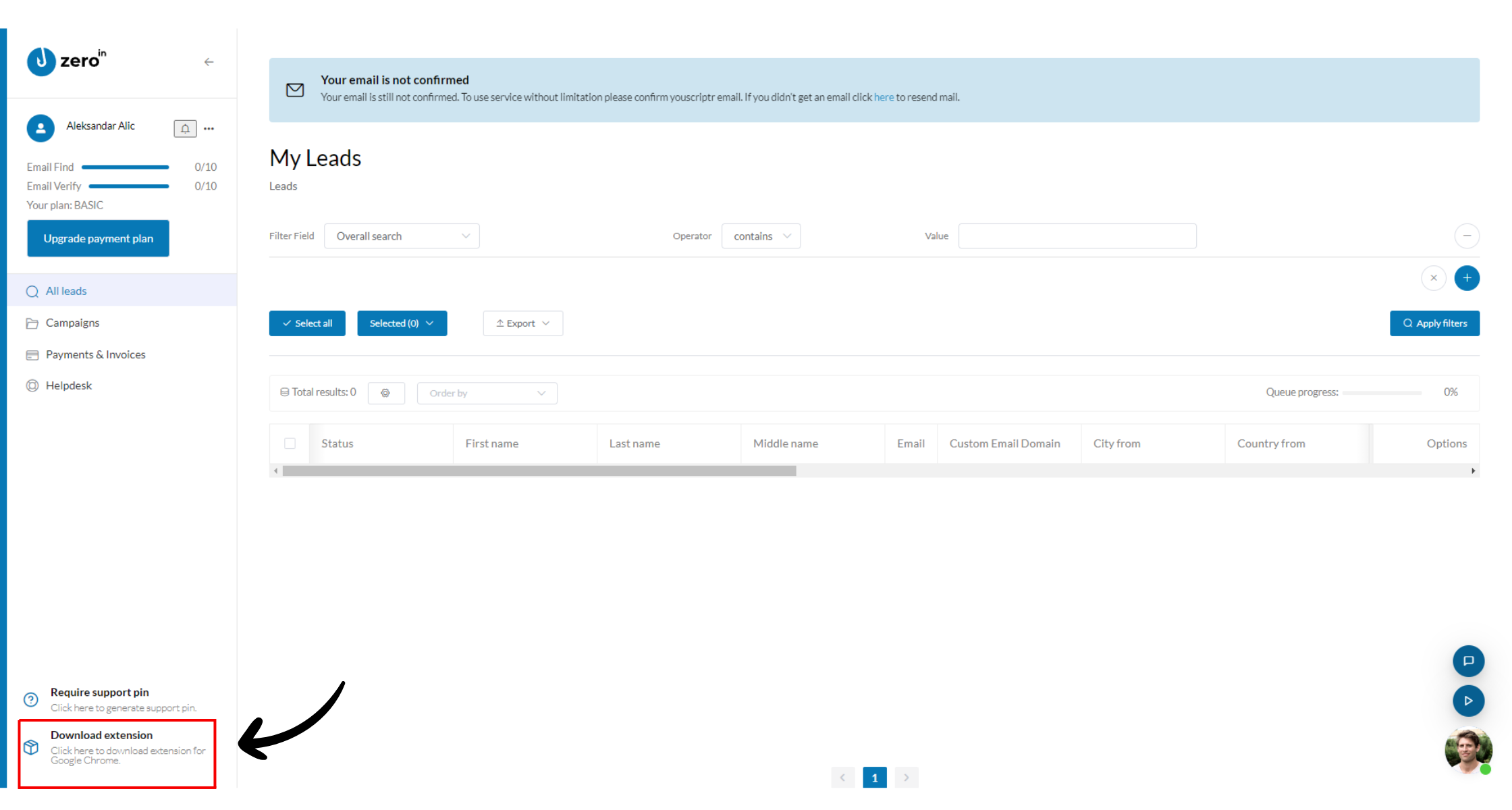
3. Log into Sales Navigator: Visit your Sales Navigator account and ensure you’re also logged into the ZeroIn extension.
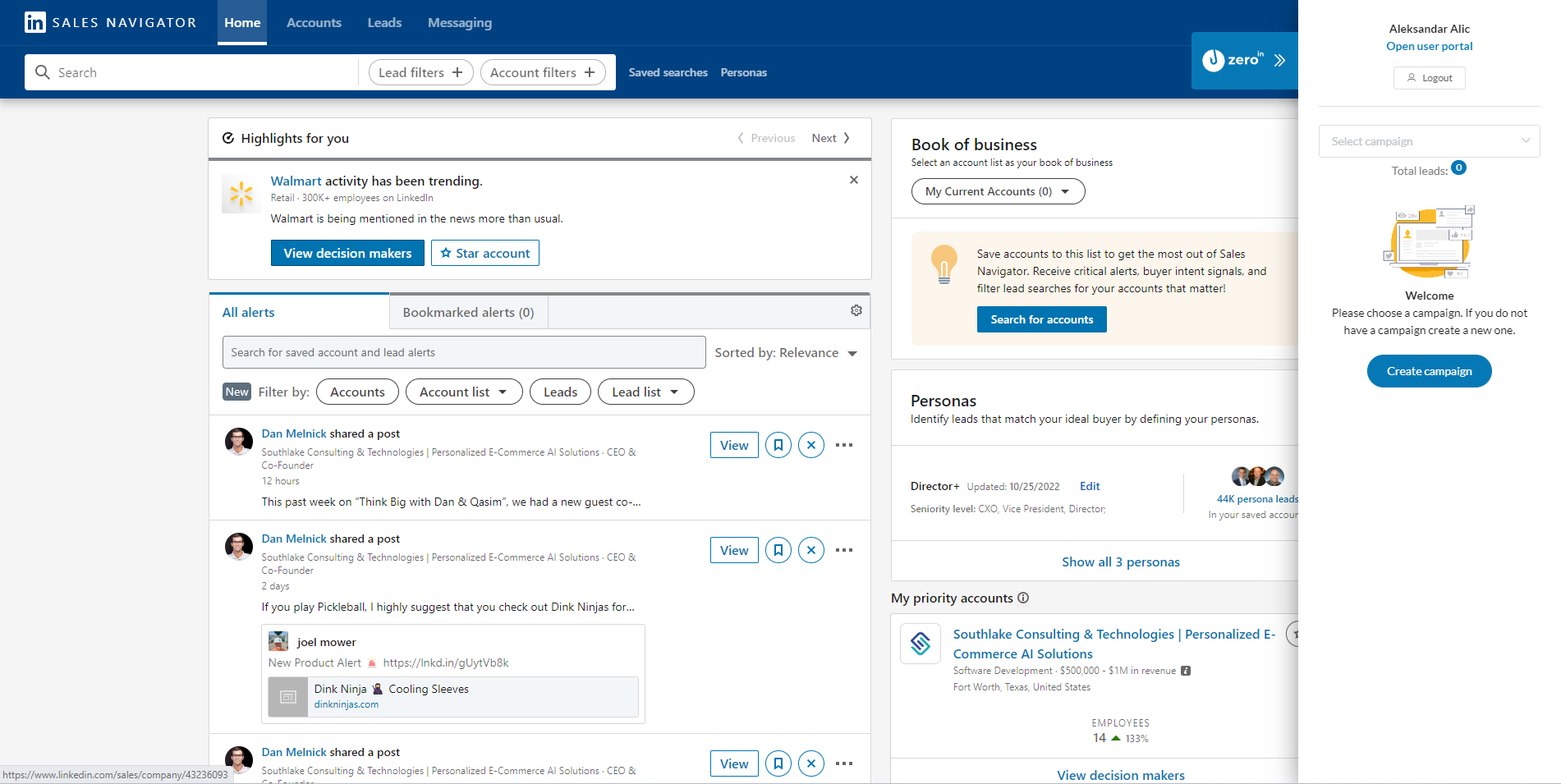
4. Select Your Leads: In Sales Navigator, click on the ‘Leads’ tab, choose the list you’re interested in, and click ‘View in Search’.
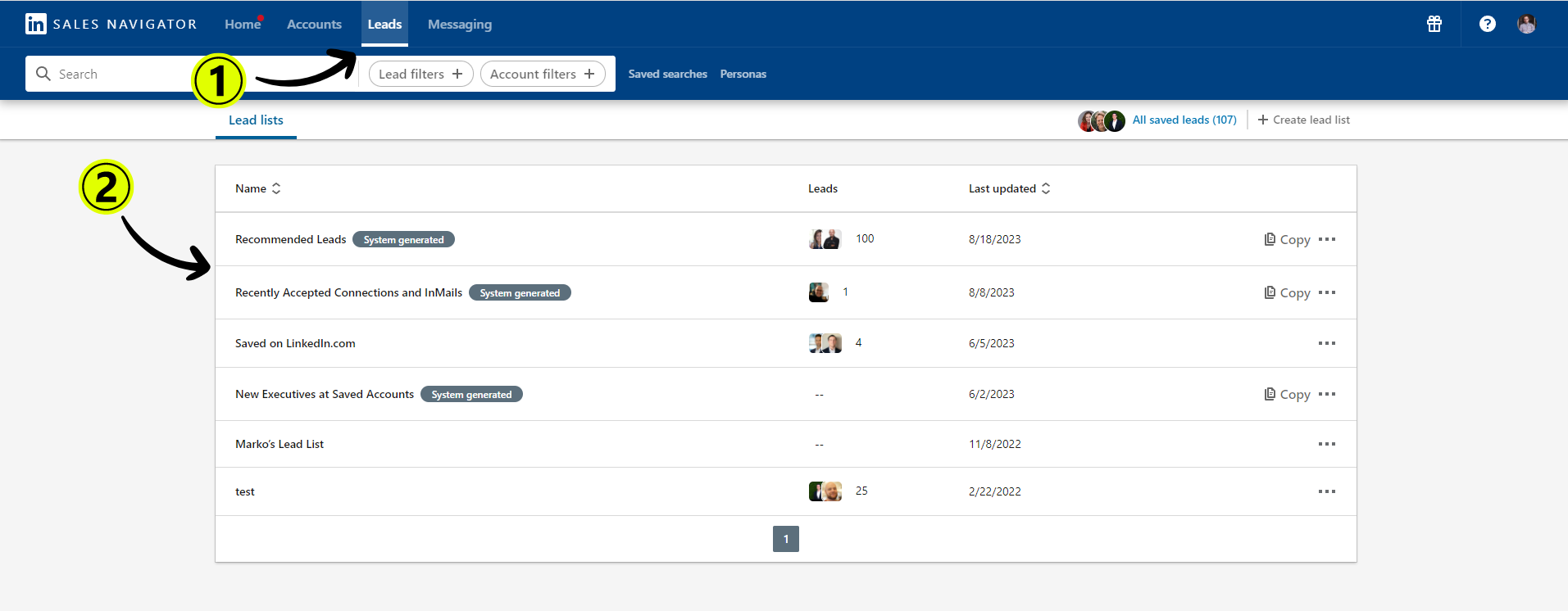
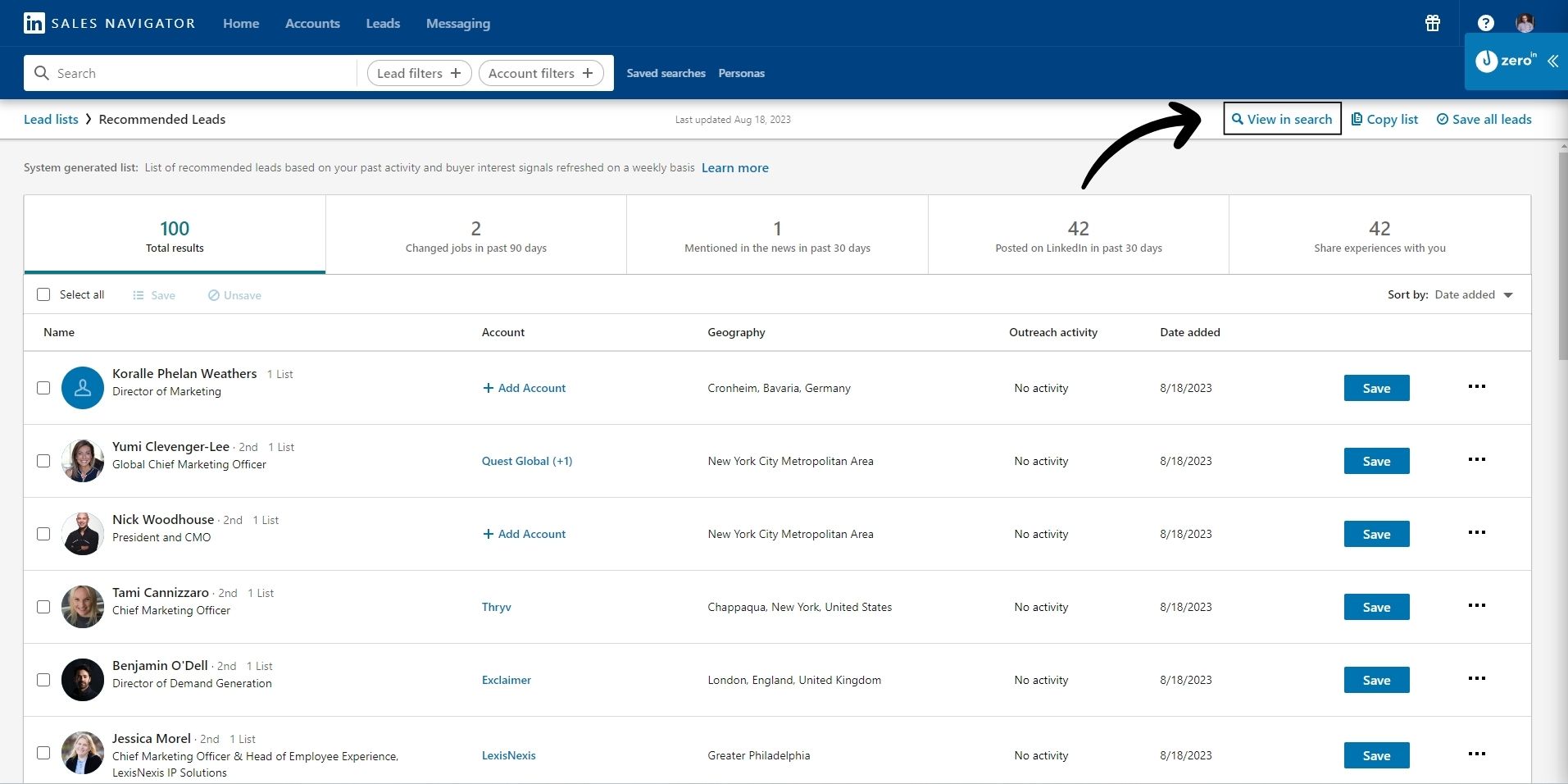
Or if you don’t have saved leads, just do the regular search.
5. Use the ZeroIn Plugin: Open the ZeroIn plugin and either create a new campaign or choose an existing one.
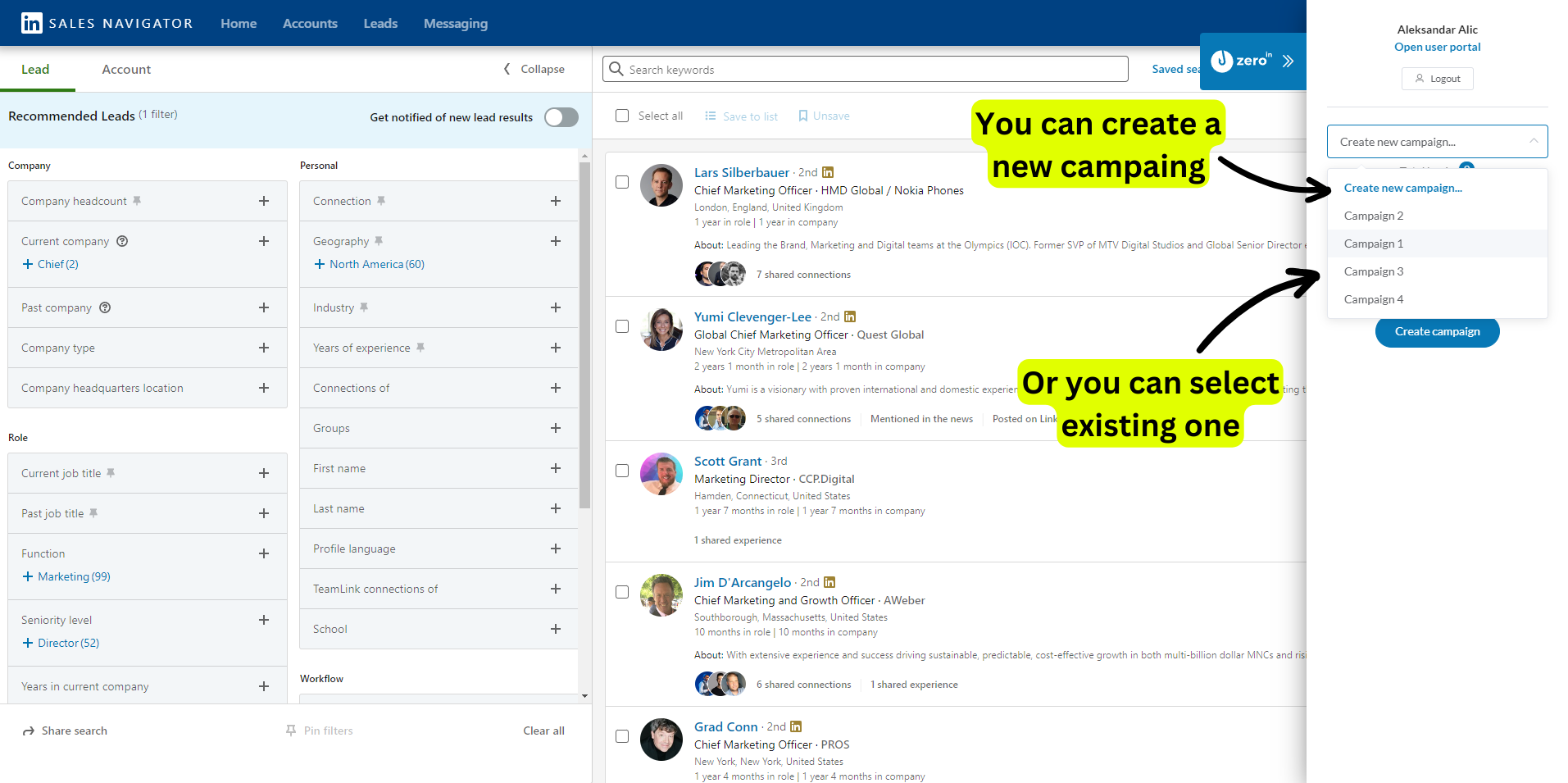
6. Set the Parameters: Decide the number of search result pages you want to extract data from. The starting page defaults to the page you’re currently viewing and can’t be altered. After setting your parameters, click ‘Fetch’.
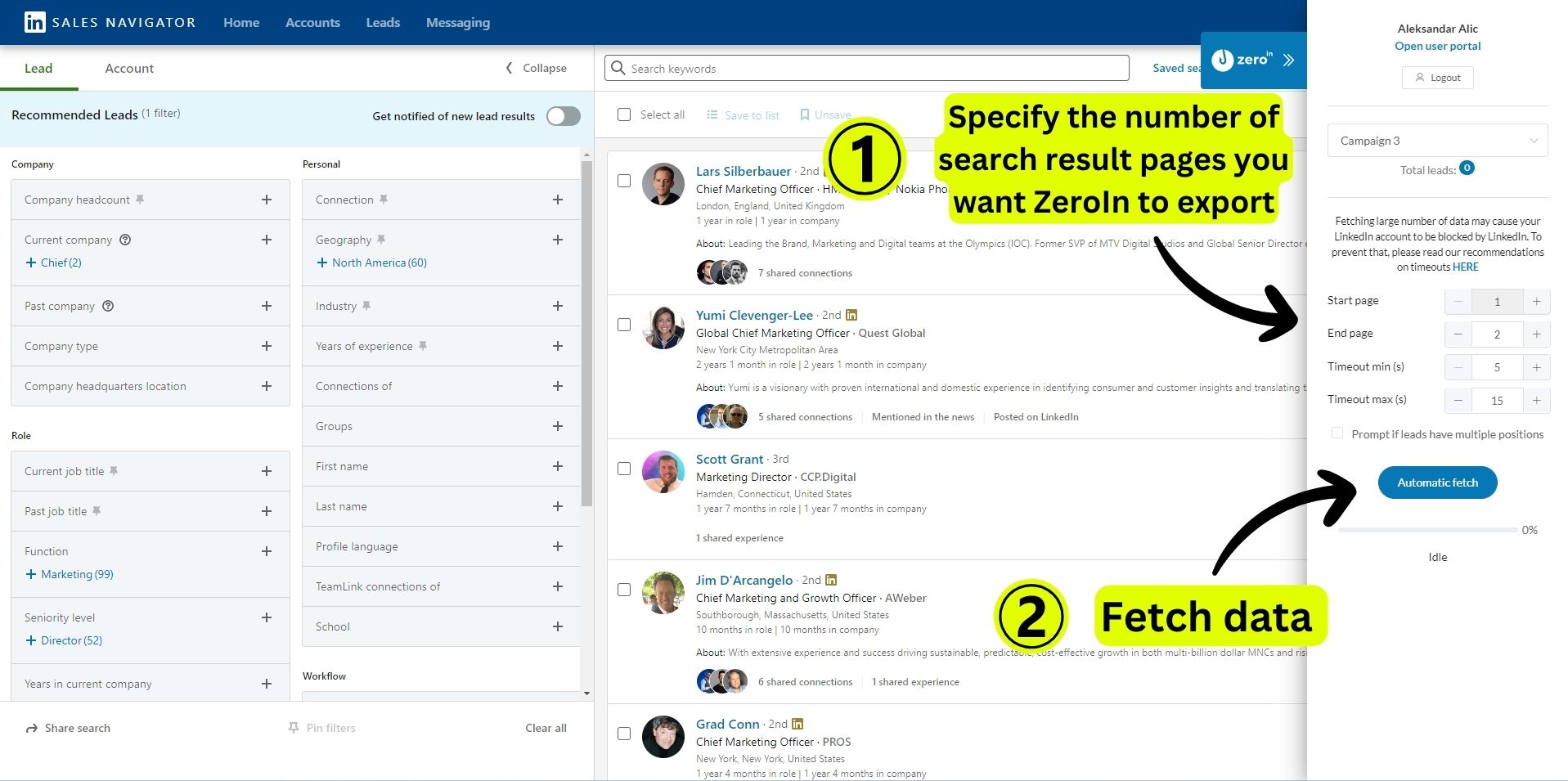
7. Return to ZeroIn: Once the data collection process finishes, navigate back to your ZeroIn portal and click on the campaign where you’ve imported your leads.
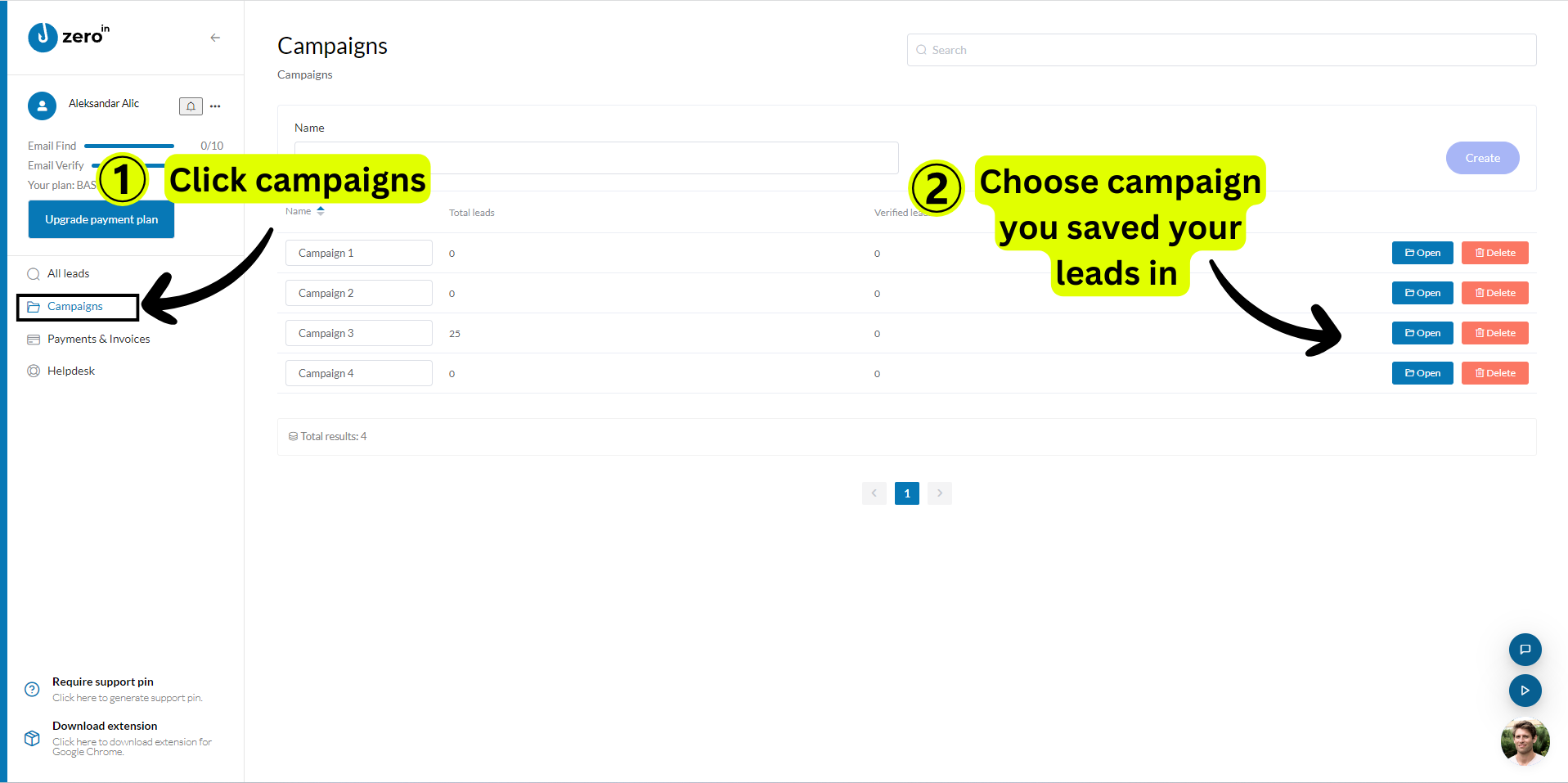
8. Export Your Leads: Now, you’re all set to export your leads. You can choose to export all leads or select specific ones. Hover over the ‘Export’ icon to see a dropdown list of data formats. For this guide, click on CSV.
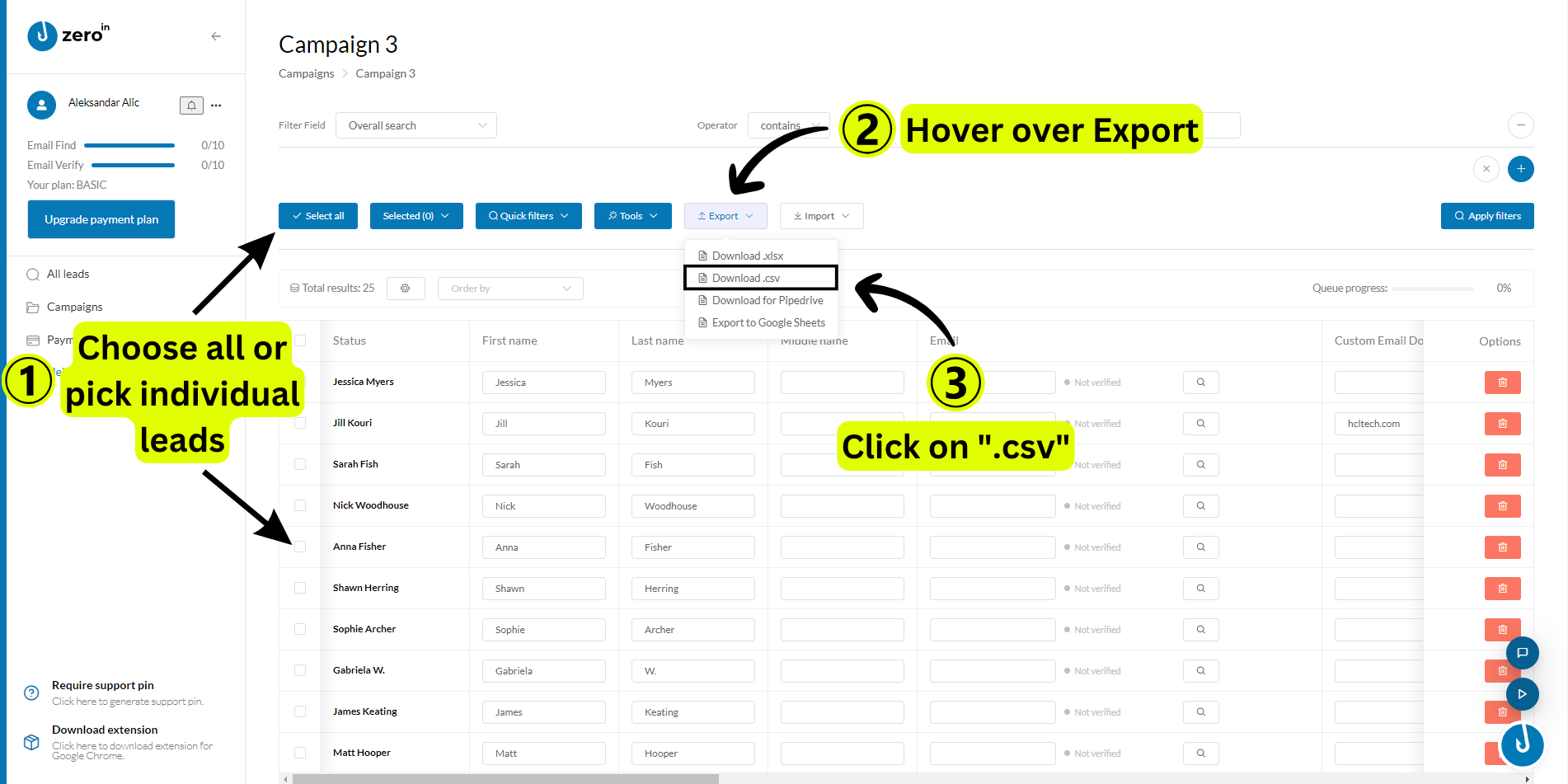
These steps should help you seamlessly export your carefully curated leads into a CSV file, making your data management more efficient and your outreach more organized.
Verify their Email Addresses
Having your leads’ email addresses can significantly augment your outreach strategy.
After extracting the leads and exporting them to a CSV file, you can take an extra step with ZeroIn to find and verify the email addresses of these leads.
Here’s how:
1. Navigate to the ZeroIn User Portal: After you’ve extracted your leads, head to the ZeroIn user portal.
2. Choose a Campaign: Select the campaign where you’ve saved your leads.

3. Select Your Leads: Choose the leads for whom you wish to find email addresses.
4. Add to Email Find Queue: Click ‘Selected’ and from the dropdown, choose ‘Add to email find queue’.
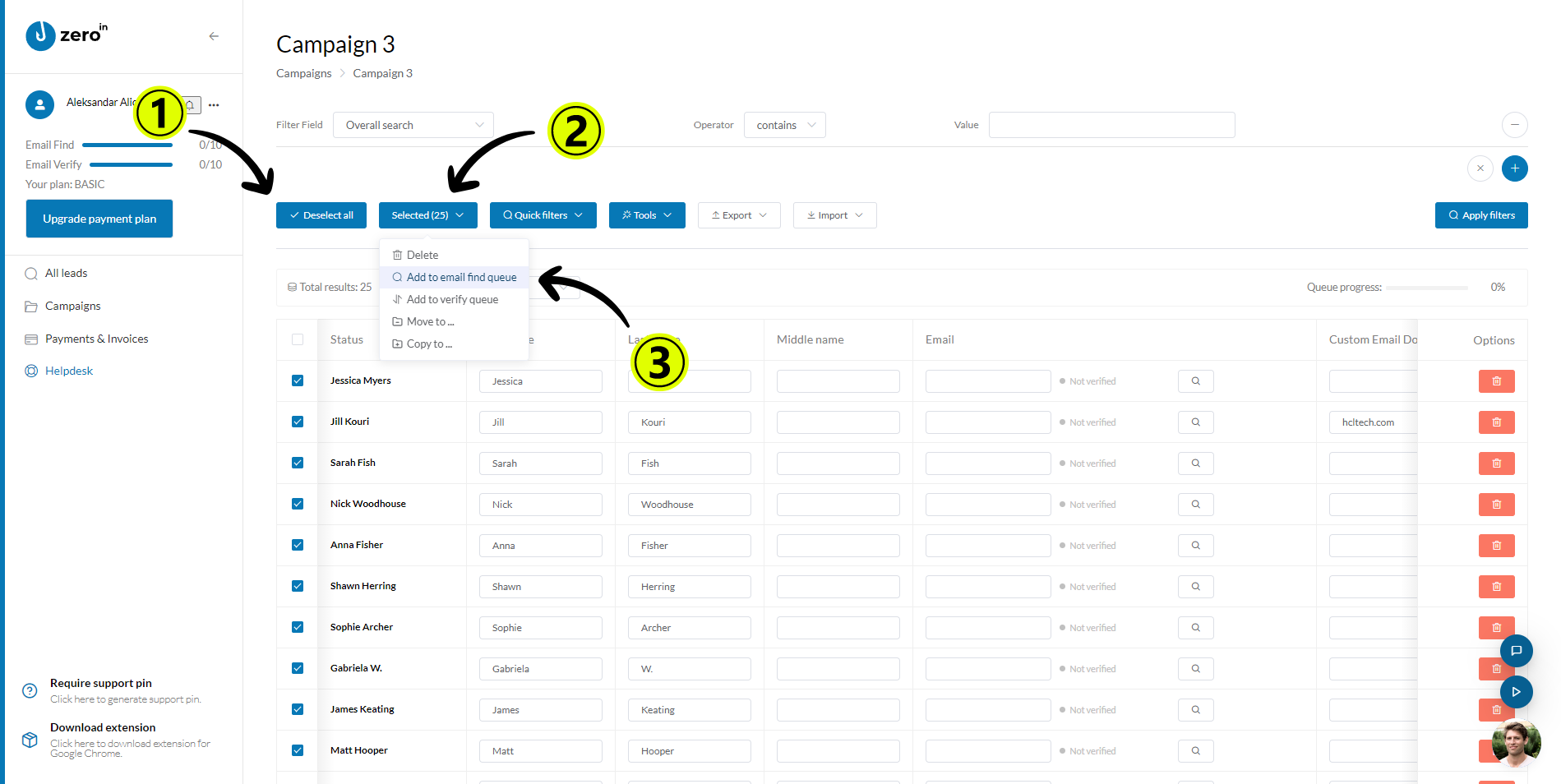
ZeroIn will then embark on the task of locating each lead’s email address.
This process takes a while as it ensures that the found emails are verified and not just random guesses.
When it’s done, you’ll have a list of verified email addresses, ready to be utilized in your outreach campaign.
It adds another dimension to your strategy, allowing for more personalized and direct contact with your potential leads.
Configure your LinkedIn Outreach Campaign
Once you’ve got your leads uploaded into your LinkedIn outreach tool, the next big step is to configure your campaign.
This process involves defining your communication strategy, personalizing your messages, and setting the delivery parameters.
Starting with your communication strategy, you need to decide on the sequence of your messages.
Will you start with a connection request or a direct InMail?
Will you follow-up with an email if there’s no response on LinkedIn?
These are the questions you need to answer to plot the trajectory of your campaign.
Next, we come to personalization.
Remember, your prospects are not just faceless entries in a CSV file – they’re real people with unique interests and responsibilities.
Your campaign should reflect this.
Use the data you have to customize your messages, tailoring each one to speak directly to the recipient.
Referencing their job role, industry, or recent LinkedIn activity can help make your messages more engaging.
Finally, you need to set your delivery parameters.
How many messages will you send per day? At what intervals?
It’s important to strike a balance here.
Too many messages can come off as spammy, but too few might mean missed opportunities.
Also, consider the timing of your messages to increase the chances of them being seen and responded to.
In summary, configuring your campaign involves strategy, personalization, and careful scheduling.
Doing it right increases the effectiveness of your outreach, leading to more responses, more connections, and ultimately, more leads for your business.
Send Personalized Messages
We’ve all been at the receiving end of generic messages that lack a personal touch.
They’re easy to spot and, more often than not, easy to ignore.
So, when you’re crafting your messages, remember that personalization is paramount.
Here’s how you can do it:
Begin with their Name: Always address your prospect by their first name. It immediately grabs attention and creates a feeling of connection.
Acknowledge their Role and Company: Mentioning your prospect’s job role or company signifies that your outreach isn’t random. It’s a targeted effort because you’ve found something interesting or relevant in their profile.
Refer to their Content: Did your prospect recently share a noteworthy post or article? Perhaps they’ve just celebrated a work anniversary or a promotion? Such events make for excellent conversation starters. Use them to show that you’re genuinely interested in what they’re doing.
Align with their Needs: Your product or service should be a solution to a problem your prospect is facing. So, tie your message with their pain points and highlight how you can provide a solution.
Keep it Brief: While personalization is crucial, maintaining brevity is equally important. Keep your message concise and to the point. LinkedIn messages have a 300 character limit for a reason.
End with a Question: Encourage a response by ending your message with an open-ended question. This transforms your message from a monologue into a potential dialogue.
Remember, your goal is to build a genuine connection, not to push a hard sell.
So, while personalizing your messages, maintain a professional yet friendly tone.
If done right, personalized messages can turn cold outreach into warm, receptive conversations.
Now, having reached out once, should you sit back and wait?
Definitely not.
The power of following up cannot be stressed enough, and that’s what we’ll discuss next.
Follow-up at least 3 times
A key aspect of a successful outreach strategy is follow-ups.
Many professionals tend to underestimate the importance of following up, especially when the initial message goes unanswered.
However, the reality is, people are busy. Your message may get lost in the noise of LinkedIn, and that’s where follow-ups come in.
The magic number?
Three.
It may seem persistent, but in a crowded professional platform like LinkedIn, persistence is what helps you stand out.
Here’s a simple guide to structuring your follow-up messages:
1st Follow Up: Send this a few days after your initial message. Keep it simple – ask if they’ve had a chance to review your previous message. Remind them of the key benefits your product or service can offer, and reiterate your eagerness to discuss further.
2nd Follow Up: This can be sent about a week after your first follow-up. Add some value this time. It could be a useful article, a pertinent piece of industry news, or any information that you believe could be beneficial to them. This reinforces your commitment to providing value.
3rd Follow Up: Send this about two weeks after your second follow-up. Politely express your disappointment at not having heard back, but ensure you communicate that you understand they might be busy. Express your hope for a future conversation and leave the door open for them to respond at their convenience.
By implementing this systematic follow-up strategy, you not only maximize your chances of a response but also foster an impression of determination and dedication.
However, it’s important to balance perseverance with respect for your prospect’s space.
Always be professional, and never come across as desperate or pushy.
Of course, keeping track of all your outreach efforts can become quite a task. That’s why our next step is crucial: Tracking it with a Light CRM.
Track LinkedIn Outreach with Light CRM
As you venture into the land of LinkedIn cold outreach, you’ll quickly realize the importance of tracking your activities.
That’s where Light CRM enters the scene – your personal command center, keeping you updated on every campaign.
Imagine this: You’ve sent out hundreds of messages and you’re waiting for responses. But without a proper tracking system, how do you know who responded, who’s interested, and who ignored your message?
That’s where Light CRM shines, as it gives you a clear picture of your campaigns.
Here are the benefits:
Organize Your Leads: Light CRM helps you maintain a structured database of your leads, storing all essential information like their LinkedIn profiles, email addresses, industry, and even the stage of the outreach process they are in.
Monitor Campaign Progress: It offers you real-time insights into your campaigns. You can check how many messages you’ve sent, the number of responses you’ve received, and track the progress of each outreach effort.
Automate Follow-ups: Most Light CRMs allow you to automate your follow-ups. This ensures that no potential lead falls through the cracks due to human error or forgetfulness.
Measure Success: It enables you to measure the success of your campaigns. By tracking the response rates and engagements, you can calculate your conversion rate and make informed decisions for future campaigns.
Ultimately, a Light CRM transforms the chaos of cold outreach into an organized, streamlined process.
It saves you time, reduces stress, and maximizes your results.
So, while you’re busy sparking conversations and building relationships on LinkedIn, let your Light CRM handle the operational details.
Our 5 Tips on Writing Perfect LinkedIn Cold Outreach Message

Now that you’ve gathered your leads, refined your LinkedIn profile, crafted your outreach campaign, and set your CRM to track your progress, it’s time to focus on the quintessence of cold outreach – the messages themselves.
Even with all your preparations, a poorly written message can prove to be the Achilles’ heel of your strategy.
A well-crafted message strikes the balance between personalization and professionalism, grabbing your prospect’s attention, piquing their curiosity, and prompting them to engage in a conversation.
These messages are more than just strings of words – they serve as the first handshake, the initial rapport-building phase, and sometimes, the determining factor of whether a prospect becomes a lead.
With this in mind, we present our top 5 tips for writing the perfect LinkedIn cold outreach message.
These guidelines will help you create messages that resonate with your audience, making them more likely to respond positively.
Let’s dive in.
Tip #1 – Personalize Your Approach
In an ocean of generic, copy-pasted messages, a personalized note stands out like a lighthouse.
Your prospects are individuals with unique needs, aspirations, and experiences.
Acknowledge this fact by personalizing your messages.
Personalization goes beyond addressing your prospects by their names.
Delve into their profiles and discover their roles, their achievements, or even the industry events they’ve attended.
Are they passionate about a specific cause?
Have they recently published an article or won an award?
Use this information to craft a message that shows you’ve done your homework.
A personalized approach demonstrates your genuine interest in them, not just as potential leads, but as professionals in their respective fields.
It adds a human touch to your message, which is crucial in building trust and rapport.
Remember, people are more inclined to engage with those who show they truly care.
Here’s an example of a personalized message:
“Hi [Name],
I noticed you recently won the ‘Innovator of the Year’ award.
Congratulations!
As someone who appreciates innovation in the tech industry, I’m impressed by your achievements.
I’d love to discuss how our software could further aid your creative processes.“
With this level of personalization, your message will shine through the mass of generic outreach attempts. It’s like a personalized invitation in a stack of bland, impersonal flyers. And who doesn’t appreciate a bit of personalized attention?
Tip #2 – Be Concise
Time is a scarce resource, and nobody appreciates having theirs wasted.
When crafting your cold messages, remember the value of being concise.
Long, winding messages can be a chore to read and may discourage your prospects from even responding.
Remember, your initial message isn’t the place to share the entire story of your company or product.
It’s a hook, a teaser designed to spark interest and inspire further conversation.
Be straightforward about your intent, and summarize what you offer in a compelling, yet digestible manner.
Here’s an example:
“Hi [Name],
As a leader in your field, I thought you might be interested in our AI-driven project management software.
It simplifies team coordination, improves task tracking, and enhances productivity.
I’d be happy to give you a quick run-through if you’re interested.“
In just three sentences, this message gets straight to the point, makes an offer, and invites further conversation.
It respects the recipient’s time while maintaining their interest.
It’s like delivering an elevator pitch: clear, concise, and compelling.
Your prospects will appreciate your respect for their time and may be more likely to engage with your message.
Tip #3 – Avoid Jargon
Engaging in industry speak or using technical jargon can be tempting, especially when you’re talking about your product or service.
However, not all of your prospects will be familiar with these terms, and even if they are, they might find your message unnecessarily complex or even intimidating.
Your aim is to build rapport, not alienate your prospects with a lexicon they need a dictionary to understand.
By using clear and simple language, you can ensure that your message is understood by everyone, irrespective of their familiarity with your field.
Imagine, for instance, that you’re reaching out to a marketing director about your SEO software:
“Hi [Name],
I noticed you’re doing great work in marketing at [Company].
I represent a tool that can simplify SEO strategy execution and enhance your visibility online.
I’d love to provide a quick demo if you’re interested.“
By cutting out the jargon, you’ve made your message approachable, even to someone who might not be intimately familiar with SEO.
So, when penning your cold message, remember the adage: KISS – Keep It Simple, Silly.
You’ll be surprised at how much more engagement you’ll receive.
Having some templates can also help with this.
Tip #4 – Articulate a Clear Value Proposition
Your prospects are inundated with sales pitches and promotional messages every day.
To get their attention, you must offer them something they can’t resist.
This is where a compelling value proposition comes into play.
Your value proposition should clearly articulate what you offer, how it benefits the recipient, and why it’s different or better than what competitors are offering.
Let’s say you offer a project management tool.
A value proposition could look something like this:
“Hello [Name],
I see that you’re managing numerous projects at [Company].
Our tool has helped similar companies streamline their project management process, cutting down time spent on organization by 40% and boosting productivity.
I would love to show you how it can do the same for your team.“
This message immediately highlights the value of your tool – time-saving and productivity-boosting.
Moreover, it appeals to your prospect’s pain point of managing numerous projects, thus making it more likely to pique their interest.
Remember, your value proposition is not about boasting your product’s features, but rather about spotlighting how it can solve your prospect’s problems or improve their situation.
Get this right, and you’ll see your response rate soar.
Again, templates like this can can save you a lot of time.
Tip #5 – Seal the Deal with a Powerful Call-to-Action
Crafting the perfect message can get your foot in the door, but it’s the compelling call-to-action (CTA) that ushers your prospects inside.
A powerful CTA can be the difference between a polite nod of acknowledgment and a warm handshake of engagement.
A good CTA does more than just round off your message – it nudges your reader towards the next step.
Be it scheduling a meeting, a phone call, or an opportunity for further discussion, your CTA should instill a sense of urgency and demonstrate clear benefits.
Remember, LinkedIn is a professional platform, and people are bombarded with messages daily.
If you don’t ask them to do something specific after reading your message, they’ll likely move on to the next thing, and your golden opportunity might be lost in the ether of their busy schedule.
A CTA doesn’t need to be grandiose or audacious.
In fact, subtlety and simplicity can often work best.
You might prompt your new connection to check out a particular blog post, sign up for a webinar, or schedule a brief call to discuss their needs further.
The key is to make the next step as frictionless and enticing as possible.
Example:
“If you’d like to learn more about how our software can revolutionize your team’s efficiency, feel free to check out this case study we recently published [insert link].
If it resonates, I’d love to schedule a quick call to discuss how we can tailor this solution to your needs.“
In the end, LinkedIn outreach isn’t just about sending messages. It’s about crafting compelling narratives that engage your audience and move them towards action. So, write your story, write it well, and always remember to end it with a powerful call-to-action.
Extra Knowledge: Our 3 Proven LinkedIn Cold Outreach Strategies
Adequately equipped with the tips to write a perfect LinkedIn cold outreach message, it’s time to step up your game.
What you’re about to discover are not just theories but battle-tested strategies that have proven their mettle in the marketplace.
These methods have been honed and refined, extracting wisdom from the success and failures of thousands of LinkedIn outreach campaigns.
Are you ready to step into the advanced realm of LinkedIn cold outreach?
Let’s delve into our three tried-and-true strategies that you can employ to supercharge your
LinkedIn outreach initiatives and begin reaping significant results.
Strategy #1: The Slow Cook Approach
Success, they say, is a marathon, not a sprint.
This aphorism holds particularly true in the context of LinkedIn cold outreach. The ‘Slow Cook Approach’ is a strategy rooted in patience, persistence, and steady, continuous engagement.
Instead of rushing in with a sales pitch right after connecting, this approach encourages you to gradually build rapport with your prospects.
Start by acknowledging their work, commenting on their posts, or engaging in discussions they initiate.
This interaction not only helps you build a relationship but also provides valuable insights about the prospect’s interests and business needs.
As the name suggests, the Slow Cook Approach takes time.
It’s about letting the relationship mature at its own pace, allowing trust to build and interest to be piqued.
But once it reaches that critical point, the results can be nothing short of exceptional. The prospect now recognizes you as a consistent and insightful presence, not a faceless salesperson.
This paves the way for a much more receptive and fruitful conversation when you finally introduce your service or product.
Remember, this strategy requires time, patience, and dedication.
However, when done right, it yields relationships that are stronger, more meaningful, and ultimately more profitable.
It’s a testament to the old adage, “Good things come to those who wait.”
Strategy #2: The Topical Connection Method
The second strategy on our list, the ‘Topical Connection Method,’ is all about creating shared relevance with your prospect.
In this era of personalized marketing, a ‘one-size-fits-all’ approach to outreach is likely to fall flat.
Your message needs to resonate with your prospect’s immediate concerns, interests, and business environment.
This strategy involves thoroughly researching your prospect to understand their business, industry, and personal interests.
Scan their LinkedIn activity, company news, and the broader industry landscape to identify topical issues, trends, or challenges relevant to them. The goal is to find a theme that you can hook your outreach message onto.
Once you’ve identified a suitable topic, you craft a message that draws a connection between this topic and your offering.
For instance, if your prospect recently published an article about remote work challenges, and your company offers a project management tool, your message could focus on how your solution addresses these challenges.
The Topical Connection Method takes more preparatory work than a generic outreach campaign.
Still, it dramatically improves your chances of grabbing the prospect’s attention.
By demonstrating your understanding of their industry and needs, you not only differentiate yourself from other vendors but also present a compelling case for your product or service.
Strategy #3: The “Pay it Forward” Method
Our third and final strategy flips the typical outreach model on its head.
Rather than starting your message with a request or a pitch, you lead with a gesture of goodwill. This is the “Pay it Forward” Method.
The idea behind this approach is simple yet profound: before asking for anything, give something of value first.
This could be an insightful industry report, a piece of original research, a personalized content piece, or even a simple word of advice.
The intention is to establish rapport, trust, and reciprocity before you introduce your product or service.
Here’s how it works:
You initiate the conversation by offering something that your prospect would find valuable.
It’s important that this offer is personalized and relevant, which again requires a good understanding of your prospect’s business and needs.
After providing value and building some rapport, you then transition into a soft pitch for your product or service.
For instance, if your prospect is in the retail industry, you might start your message with an offer to share a recent study you conducted on the impact of e-commerce trends on brick-and-mortar retailers.
After discussing the report and its insights, you can then introduce your e-commerce solution and how it can help them adapt to these trends.
The “Pay it Forward” Method can be more time-consuming than other approaches, as it requires you to create or find valuable content for each prospect.
However, it’s an incredibly effective way to break through the noise and start a meaningful conversation.
By demonstrating upfront that you’re interested in their success, you’re much more likely to capture their attention and earn their trust.
Conclusion
Congratulations!
You’ve come a long way since the beginning of this article.
From being that bewildered IKEA customer, you’ve morphed into a confident assembler, adeptly navigating your way around the complexities of LinkedIn cold outreach.
Did it require some patience?
Absolutely.
Were there moments of doubt?
Probably.
But in the end, you are now equipped with a toolbox brimming with practical knowledge and potent strategies.
You’re not just ready, you’re primed for success on LinkedIn.
So what’s next, you ask?
It’s time to stop reading, and start doing.
The blueprint is laid out in front of you.
Every tip, every trick, every strategy we’ve discussed, they are all yours to implement.
Your journey from here is less about collecting knowledge, and more about applying it.
And remember, outreach, at its core, is about building connections and creating relationships.
And like all relationships, it requires authenticity, patience, and a dash of creativity.
There’s no magic formula or secret recipe.
Each conversation is a blank canvas, waiting for your unique touch.
As you step into the realm of LinkedIn outreach, know that each conversation you initiate, each connection you make, contributes to the grand mosaic of your professional journey. Some tiles might not fit perfectly, and that’s okay.
Each misstep is a stepping stone towards improvement, a chance to refine your strategy and hone your skills.
Finally, in the words of Nelson Mandela, “It always seems impossible until it’s done.”
So, go forth and conquer LinkedIn, one connection at a time.
You’ve got this, and remember, we’ve always got your back.
Now, let’s start assembling those connections!
With that, we sign off, leaving you with a world of opportunities on LinkedIn waiting to be tapped.
The playground is yours to explore.
Go make your mark!
Until next time, keep connecting, keep engaging, and most importantly, keep being you. That’s the real secret of effective LinkedIn outreach.
What is ZeroIn?
Consider ZeroIn as the remarkable assistant you never knew you needed. A wizard in the realm of email discovery and data extraction, ZeroIn’s raison d’être is to amplify your business prospecting ventures.
Like a trusted companion, it navigates through the vast LinkedIn terrain via an ingenious browser extension. Adhering to your search specifications, ZeroIn sketches comprehensive portraits of prospective clients from its rich data repositories.
But it doesn’t stop there.
ZeroIn’s commitment to authentic, verifiable data, is truly the cherry on top, and it is realized through an exhaustive 10-step verification journey.
In the grand landscape of lead information, consider ZeroIn as your steadfast sherpa, proficiently managing the import, re-validation, and export of leads across various formats. Think of it as a vital, well-oiled gear in your outreach campaign machinery.
How can ZeroIn help your business?
But ZeroIn doesn’t just sit pretty on your browser. Its purpose is far more profound. The primary mission that drives ZeroIn is fueling your business expansion by simplifying and streamlining the convoluted process of building a prospect list.
With its advanced feature set and user-friendly interface, ZeroIn turbocharges the discovery and validation of prospect email addresses, irrespective of whether you’re looking for one or one thousand.
What really sets ZeroIn apart is its unique duplicate finder. Acting as a vigilant guard, it ensures the accuracy and freshness of your CRM data, optimizing your resources and saving your precious time.
The one-time, lifetime payment deal, is particularly enticing for small to medium-sized businesses who are in pursuit of an efficient and cost-effective solution for email discovery and management.
In partnership with ZeroIn, you can elevate your outreach strategies, connect with the right people, and supercharge your business growth at a pace you’ve never experienced before. It’s the secret ingredient to your LinkedIn success recipe!
Create a Free Account and Get 25 credits!
FAQs
What is considered as Cold Outreach on LinkedIn?
LinkedIn cold outreach is the act of identifying and reaching out to potential clients, partners, or collaborators on LinkedIn whom you’ve had no prior contact with.
Why should you utilize LinkedIn as your “Go-To’’ for Cold Outreach?
Here are a few reasons why LinkedIn should be your go-to platform for cold outreach:
1. Less Flooded Inbox
2. Higher Response Rate
3. Professional Environment
4. Powerful Search and Segmentation Tools
5. Potential for Warm Introductions
6. Constant Evolution
How to Perform Cold Outreach On LinkedIn in 2023?
Here’s how to perform cold outreach on LinkedIn effectively:
1. Send LinkedIn Connection Request First
2. Send Direct Messages
3. Send InMails if first you don’t get a response
4. Join LinkedIn groups or Attend Events as it allows you to send Message Requests to fellow group members or event participants
How to Prepare for Cold Outreach on LinkedIn?
While diving headfirst into LinkedIn cold outreach might sound exciting, preparation is key to ensuring your efforts yield the desired results.
Here are the steps you need to take before launching your LinkedIn cold outreach campaign:
1. Prepare your Linkedin profile for your Prospects
2. Utilize LinkedIn Sales Navigator for Finding Leads
3. Use Linkedin Boolean Search
4. Export your leads into CSV file
5. Verify their Email Addresses
6. Configure your LinkedIn Outreach Campaign
7. Send Sersonalized Messages
8. Follow-up at least 3 times
9. Track LinkedIn Outreach with Light CRM
How to write a Perfect Linkedin Cold Outreach message?
Top 5 tips for writing the perfect LinkedIn cold outreach message:
1. Personalize Your Approach
2. Be Concise
3. Avoid Jargon
4. Articulate a Clear Value Proposition
5. Seal the Deal with a Powerful Call-to-Action
What are strategies for LinkedIn Cold Outreach?
Here are 3 tried-and-true strategies that you can employ to supercharge your LinkedIn outreach initiative:
1. The Slow Cook Approach
2. The Topical Connection Method
3. The “Pay it Forward” Method
